The desolate silence of minimalism
By: Kieran Long | posted: 3/22/2007 1:00:00 AM
We live in an era of memorial inflation. In my hometown of London there seems to be a solemn dedication of some kind every other month, often for events and wars long past. Elsewhere, the huge and expensive memorial to the September 11th terrorist attacks is in the final stages of design, dwarfing in size and certainly cost any previous memorial, even those for world wars. In Berlin, a whole block near Potsdamer Platz in the centre of the city has been given over to a national memorial to the murdered Jews of the holocaust – the size of the gesture commensurate with the guilt that Germany feels. But it seems more than likely that even these will also be dwarfed by ever more public gestures of grief. The memorial park to the victims of the tsunami on Boxing Day 2004 is set to be one of the most lavish ever.
BILD1
The size and frequency of new memorials are increasing, even if the size and drama of the events they commemorate is no more acute than previous eras. But the public bickering over contemporary memorial design is also louder and more rancorous than it has ever been. From the rows about the cost and nature of the memorial at Ground Zero to children injuring themselves in the Diana Memorial Fountain, there seems to be something missing from the contemporary memorial designer’s armoury. Designers routinely fail to convince governments and public of the integrity of their proposals. The lack of consensus about how the dead should be honoured in cities poses the question: why don’t contemporary memorials mean anything to anyone?
Perhaps the controversy that originates the contemporary crisis was the row over the Vietnam Veterans’ Memorial in Washington DC by Maya Lin in 1982. Her memorial was the first to adopt strategies from minimalist art. It consists of a right-angled cut in the ground with 140 Indian granite panels with the names of 58,175 dead inscribed in them. This was a stark and shocking gesture, completely shorn of representation. No columns, arches, laurel leaves or even regimental insignia, it was a bold and radical departure.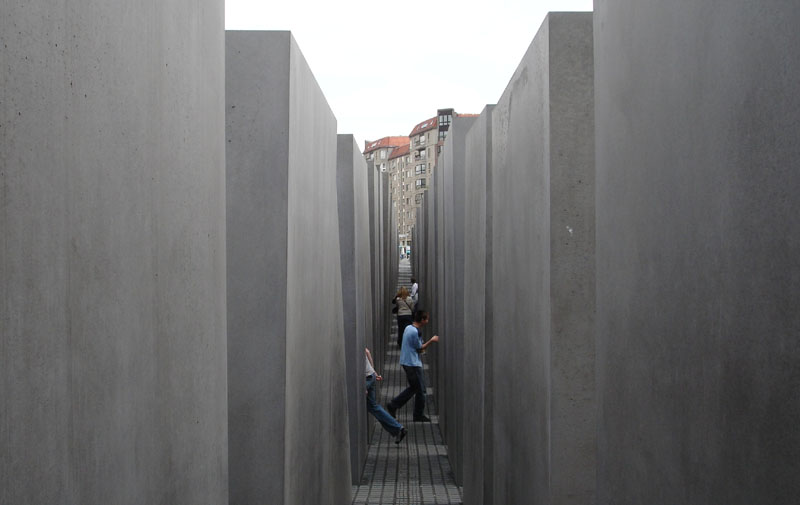
The Memorial to the murdered Jews of Europe by Peter Eisenman. Photo by Jon Brunberg.
The building (and its author - Lin was 22 years old, Chinese-American and a woman) was very controversial. The silence of the visual language was an affront to many, particularly those in the forces, finding it an insufficient expression of the honour due to servicemen killed in action. As a result, another memorial was built in more conventional form (a figurative sculpture of three GIs), making the Vietnam War the only war with two national memorials in the USA.
Lin’s design is tasteful and beautiful and has become the canonical contemporary memorial. Her own fame is as a direct result, and her membership of the jury for the World Trade Centre memorial is directly credited by some for the victory of Michael Arad’s minimal proposal.
The problem that many had of accepting the minimalism of the Vietnam memorial could be its ambiguity, the reticence of the minimal form in glorying in the achievements of the military in favour of commemorating loss. It is cited as a building of dignity and contemplation rather than bombast. But 20 years on, I am beginning to think that the problem was not its ambiguity, but its silence. In retrospect this minimalism looks like short-term thinking, relying on history to be recorded elsewhere or references made in text books, while the monument evokes a general sense of loss and absence.
If one accepts (as I’m not sure I fully do) that religious imagery is no longer a relevant aesthetic reference, I still fail to see how minimalism has become appropriate strategy for dealing with loss in wars. The expression of a single material buried in the ground was Lin’s one innovation (on the grounds that her strategy for listing names alphabetically is mirrored on world war 1 graveyards and monuments). It is the conspicuous dumbstruck-ness that prevails as an atmosphere, and this has set the benchmark for a whole generation of memorials that have come since. We have been told that art galleries are the new cathedrals, but can art administer the last rites as effectively?
Lin’s monument is an extraordinary achievement for many reasons, but it is time to say that her strategy opened a Pandora’s Box – no longer is eloquence required to memorialise death, but silence. Minimalism, while contemplative and seemingly universal, fails to provide the ambiguity necessary for a powerful monument for a particular culture.
In his column in June of this year, New York Times architecture critic Nicolai Ouroussoff wrote about Ground Zero that “the site remains so politically and emotionally charged that every sane proposal has unravelled.” He lamented what he saw as the value engineering of Michael Arad’s scheme and said that it has been “stripped of its meaning” in favour of creating a vast subterranean museum displaying the “relics” of September 11th.
The article is an impassioned plea for reason, but Ouroussoff misses the failures of the original scheme in his zeal to defend the architect’s vision. The problem with memorials as abstract as Michael Arad’s design is that barely anyone but the architect can grasp what is immovably meaningful about the proposal. Ok, the footprints of the twin towers are sacrosanct, and there will still be two pits there with lists of names and some waterfalls. But other parts of his proposal have proven impossible to keep sacred because they don’t seem to communicate. The descending ramps are not saveable because they have no precedent, because they are meaningless. Even Lutyens’ Memorial to the Missing of the Somme in northern France was reduced in size to 140 feet high, partly in order not to be higher than the Arc de Triomphe. But the form was not changed one iota – this was left as a decision for the artist.
Ouroussoff gave as his contrasting example the ‘success’ of the Memorial to the Murdered Jews of Europe in Berlin originally designed by Peter Eisenman and artist Richard Serra. But this field of concrete blocks was equally controversial in that city, and was 9 years in the gestation. One of the value engineering exercises undertaken on that project was the reduction in the size of the field from 4000 to 2700 stones, and the forced adjustment of the edges of the site to make them more visitor friendly by the planting of trees. This decision prompted Richard Serra to quit the project in protest. Eisenman continued, even ceding to demands for a buried interpretation centre at one corner of the site. It is a mighty impressive achievement, but to what degree is the meaning of the monument affected by its reduction in size? Is it possible to draw a line with this kind of memorial?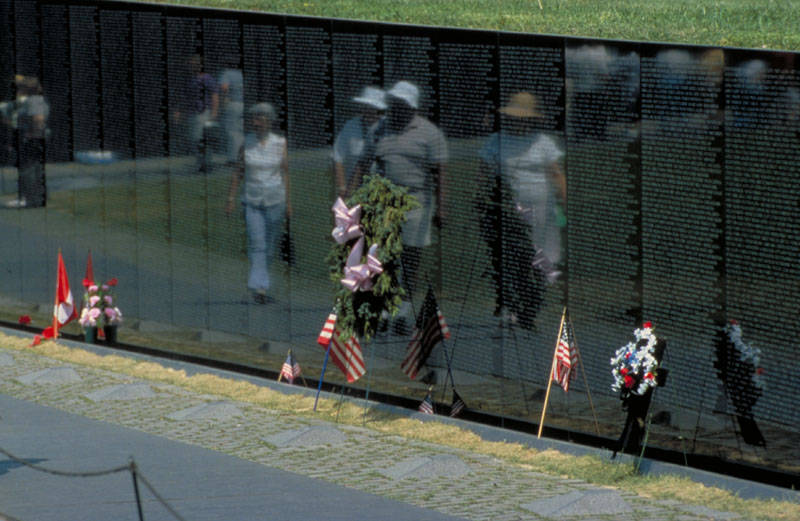
Vietnam Veterans Memorial in Washington DC by Maya Lin. Photo: US Parks Administration.
It occurs to me that the need for an interpretation centre somehow brings into relief the profound silence of this non-representational visual language. Contrast this with the approach of Daniel Libeskind, the other architect whose work is most closely associated with having an effective memorial function.
Libeskind is the master of labelling and his gestures with a non-denominational jargon. His ability to pitch the jargon of memorial at just the right level contributed hugely to his victory in the competition to master plan Ground Zero. Although the memorial was always to be separate from his overall plan, he infused the early propositions with memorial elements. A student of mine did an inventory of the gestures in the original master plan for Ground Zero – the Ring of Remembrance, Lines of Heroes, the Wedge of Light as well as the gesture of the Freedom Tower. Many of these gestures have been lost as the project has progressed. One of the most significant losses was the idea to manage the light falling across the site in such a way that on September 11th each year a particular spot in the foundations of the Twin Towers would be illuminated. This was translated later into a “wedge of light” arrangement, which was much simpler to achieve.
Whatever one thinks of Libeskind’s work, there is a certain pagan grandeur to this gesture, allowing the urbanism to be defined by the need for a commemorative function. The problem, as with all of Libeskind’s work, is that you will need a handbook to know that.
Libeskind’s strategy seems to be to build in redundancy in terms if his symbolism – some pieces will survive and these will remain meaningful despite the loss of other elements. Word has it at the moment that his “heroes lines” will make it into the final project, but that the ring of remembrance (one of the defining distinguishing features of his competition entry) seems to have been quietly dropped. But it compromises the integrity of the project for gestures to be this disposable. With his Jewish Museum in Berlin, the client erected plaques to explain what “the architect Daniel Libeskind is trying to suggest”, with the bewildering array of references manifested in the slashes in the metal façade and the paths picked out on the ground. Just as with the Eisenman memorial, interpretation is needed for the memorial to be effective.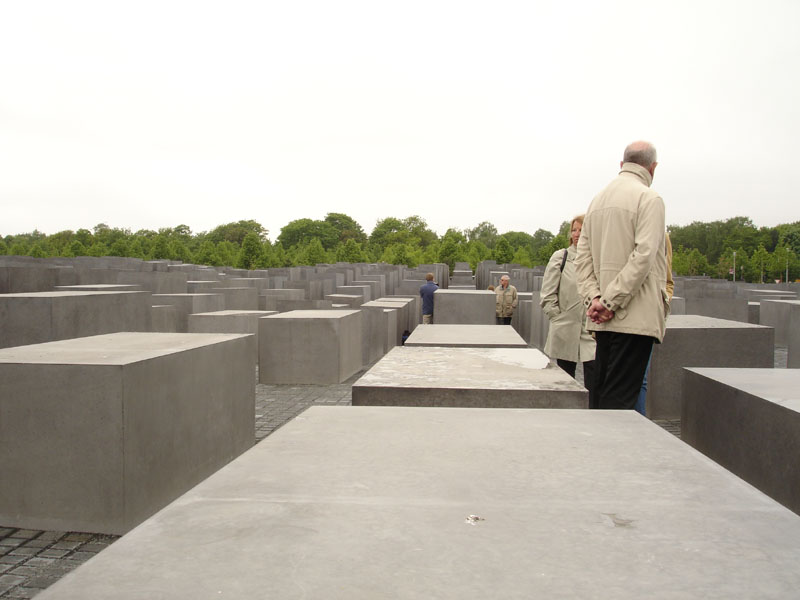
The Memorial to the murdered Jews of Europe by Peter Eisenman. Photo by Jon Brunberg.
These would seem to be the two contemporary approaches to memorials – the silent and the hyperactively talkative. But as well as these there is another, far more prevalent vision of how memorials should be, what I would loosely term the Royal Academician school of memorial building, It is certainly the most conventional and common in London, despite an increasing interest in contemporary architectonic gestures.
Typical of these is the National Firefighters’ Memorial, a bronze statue that stands outside St Paul’s Cathedral. It is the work of John Mills RA, a sculptor responsible for a number of memorials in his career. This memorial was first raised in 1990, but expanded, raised on a plinth and re-dedicated in 2003. It takes the form of an almost life-size bronze of three men engaged in fire fighting during the Blitz, a historical but somehow universal image of heroism, particularly relevant given its proximity to the cathedral – the quintessential symbol of London’s resilience under Luftwaffe attack. Mills’ most recent contribution to the public realm of London is the Memorial to the Women of World War Two. This is a much more suggestive piece, depicting (again in bronze) the uniforms of jobs that women undertook during the Second World War. It’s location could not be more prominent – on Whitehall next to the Cenotaph – and brings to mind not only the industry of women, but also their frustration and anger when, after the war, they were forced to give back much of the independence they had gained during it.
These Royal Academician sculptures are, predictably, much less tectonic statements than they are figurative and symbolic. They are things to look at rather than things to experience, and rarely do they have a spatial gesture.
Contrast this with perhaps a classic contemporary architect’s memorial, Norman Foster’s National Police memorial at Horseguards Parade. It is highly architectonic, with a space-making sensibility rather than a sculptural one. By means of a glass monolith, and another wall perpendicular to it displaying names of fallen officers, Foster created a rectangular sanctuary, defining a space to inhabit rather than an object to be venerated or looked at. The touchy-feely version of this in London is the Diana Memorial Fountain design by US architect Kathryn Gustafson, the controversial and expensive circular watercourse on the banks of the Serpentine, which has proven exceedingly popular, despite its cost overruns and technical problems. It seems that architects are uncomfortable with the creation of a communicative object, and would rather make spaces of sanctuary and repose.
This approach, much like Maya Lin’s, foregrounds the psychological powers of reflection of the visitor, rather than aspiring to teach them anything about the event itself. You sit there and look inside yourself, rather than interpreting a symbol provided by a sculptor.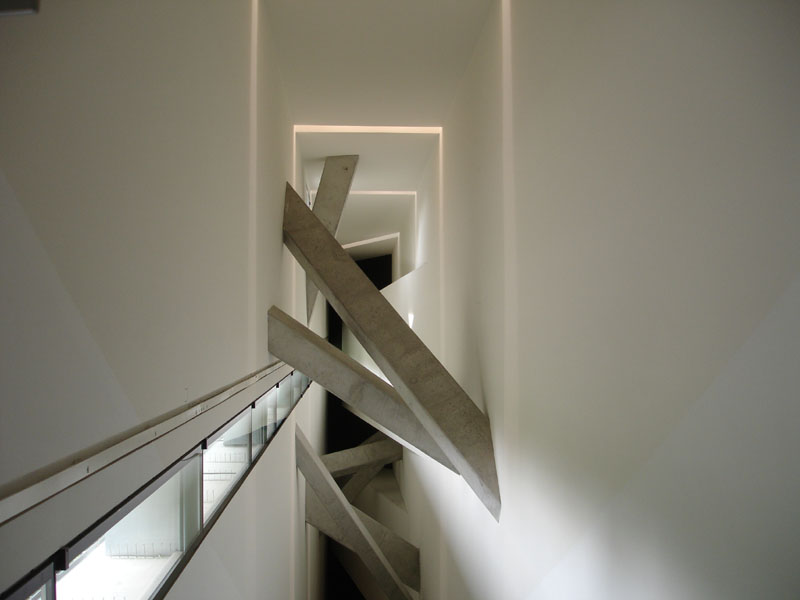
At the top of the famous staircase inside Daniel Libeskind's Jewish Museum in Berlin.Photo by Jon Brunberg
My original motivation for writing this essay is the erection of a war memorial near to my home in north London. The Islington Green War Memorial by John Maine RA, is a ring of stone, which replaces a cheap and supposedly temporary plaster obelisk that had stood on Islington Green since 1918. It is not the official war memorial of the borough, but it had stood so long that it was felt the Green should continue to have one within it. Maine’s imagery is new age hokum – the ring is square in section and twists, recalling a moebius strip – some kind of abstract circle of life imagery. That a monument to the millions killed two world wars should try to evoke rebirth and continuity so directly is a gesture of such banality and disrespect that it is difficult to believe that public money has been wasted on it.
Compare this approach to Edwin Lutyens’ work Cenotaph on Whitehall, the capital’s principal monument to the dead of the two world wars. The Cenotaph was also originally intended to be temporary, and was originally constructed in plaster in 1919. It was made permanent a year later an unprecedented public response saw 1 million visitors come to mourn there in its first year.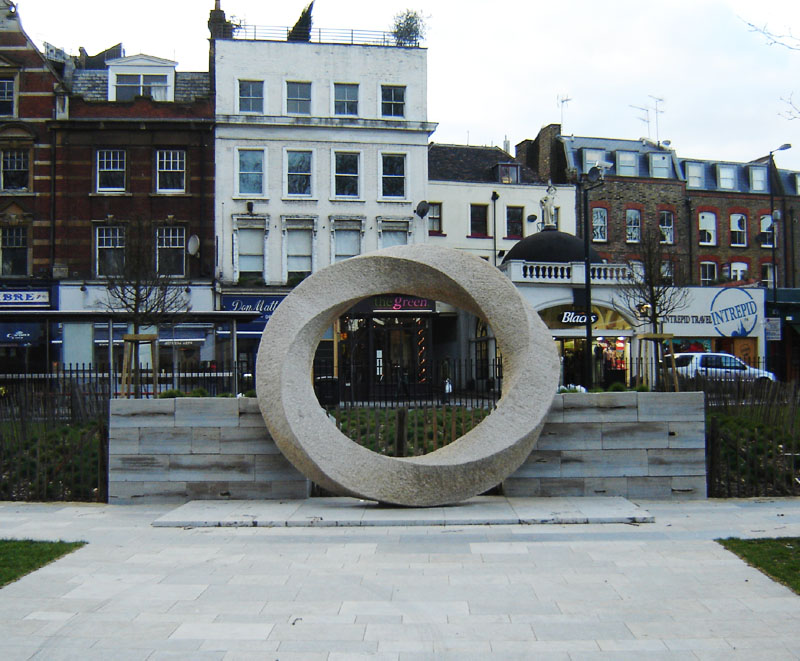
The Islington Green War Memorial. Photo by Kieran Long
The symbolism of the Cenotaph is not completely abstract – it is a catafalque, the stand for a coffin. A coffin sits on top of this stone pylon. It is universal in its emptiness and even modern in its expression, but of course recalls culturally specific rites of burial and commemoration.
Lutyens’ artistry is such that he makes any suggestion of rebirth deeply and in an almost hidden way. Gavin Stamp, in his brilliant book The Memorial to the Missing of the Somme, describes how Lutyens’ was a committed secularist and was able to convince the Imperial War Graves Commission to commit to non-religious imagery for all of its graveyards and monuments after World War One. Most significant of Lutyens’ symbols was the Stone of Remembrance, large and unadorned stones that stand in all the major monuments and graveyards of English dead from the First World War, wherever they are in the world. The stones were controversial for their lack of religious imagery (despite the stone’s cosmetic resemblance to an altar) but deep in the design lies a reference to rebirth. The edges of the stones are not straight, but subject to entasis, a Greek term for the slight curve that forms a false perspective on apparently rectilinear objects. The curve is a radius of a hypothetical sphere 1,801 feet in diameter. Lutyens was only too aware of the symbolism of the circle in many cultures’ death rites, and he was a humanist, able to marshal both conventional civilian and non-religious imagery under severe pressure from the great and good of the established church in England.
The tomb of the unknown warrior in the Westminster Cathedral was in some sense the church’s retort to the Cenotaph, a plain stone tablet with centred text justifying the burial of an unidentified soldier “amongst the kings”. Lutyens criticised this famous memorial. He wrote: “Even an unknown soldier might not have been a Christian, the more unknown the less sure you could be.”
A good proportion of the memorialising work done in England between the wars and after the second world war took on classical forms – arches and obelisks as well as crosses and figurative bronzes, carried out by a mature generation of classicist architects of which Lutyens was the most important individual.
Maine’s stone circle on Islington Green replaces a plaster obelisk form, recognisable from so many village greens and ancient in its imagery. It is inconceivable that it will endure as an image in the way that Lutyens’ brilliant monuments have.
One of the striking aspects of contemporary memorials is how quickly they are erected. Nicolai Ouroussoff’s call (link) for more patience at Ground Zero is a pretty lone voice of reason. In Northern Ireland, monuments and memorials are erected so quickly and in such sensitive locations, that they have become the very territory of profound ideological differences. When I used to visit Dublin with my Irish mother, she would show me the bullet holes in the Post Office on O’Connell Street that serve as a visceral and effective reminder of the struggle for Irish independence.
But the fraught context of Northern Ireland has become a location where memorials are directly related to, and indeed part of, the events they mark. The erection of provocative memorials, often without planning permission, has been part of the ongoing troubles, even as violent attacks subsided. Examples abound, and the facts are often difficult to establish.
Violence on the memorials themselves replaced violence to individuals. One stone RUC memorial in Armagh was vandalised by having two wreaths taken away and returned with RUC insignia removed. Recently there have also been examples of memorials being removed as gestures of goodwill, mainly from republicans. A memorial to hunger strikers in Toome was removed in 2001, and a year later in Belleek, a simple marble and stone memorial to three IRA men was removed because it stood uncomfortably close to the spot where republican gunmen had murdered a local woman.
It is interesting to note that the officially sanctioned memorials in Northern Ireland are generally intended to commemorate the dead whichever side of the conflict they were on. But this vague and universal mode does not seem to find favour. A memorial to a horrific bomb attack in the town of Claudy (almost certainly planted by a republican group, although noone ever claimed responsibility), which killed Protestants and Catholics, was erected in 2000, and is a sculpture of a weeping woman, her hands covering her face in grief. The sculptor Elizabeth McLaughlin said at the memorial’s inauguration that it was an attempt to find an "expression of the grief of the individual". This simple sculpture was intended to talk generally about personal grief and loss – the sculptor’s own mother had died in the bomb attack.
However, in October this year the statue was vandalised, removed from its plinth and lain down. In the highly tuned symbolic realm of the Troubles, this could be meaningful or mindless, but the fact remains that the physical traces of events remain disputed in Northern Ireland. The question in Ireland is the degree to which remembrance perpetuates conflict.
Lists of names is a device that has always been used for memorials, and are part of the Vietnam Veterans Memorial, the Ground Zero memorial as well as the war memorials of Lutyens and others. Names are perhaps seen as neutral, just a collection of humanity, basically innocent and equal in the eyes of whatever god they believed in. However, it is interesting to note that in The Bloomfield Report, the report that set out the agenda for memorialising the troubles in Northern Ireland, there is a call for a memorial that incorporates inscriptions, but that individual names should be avoided. This is because the thought of listing an RUC officer’s name next to the name of a member of the provisional IRA is still something intolerable for both sides. 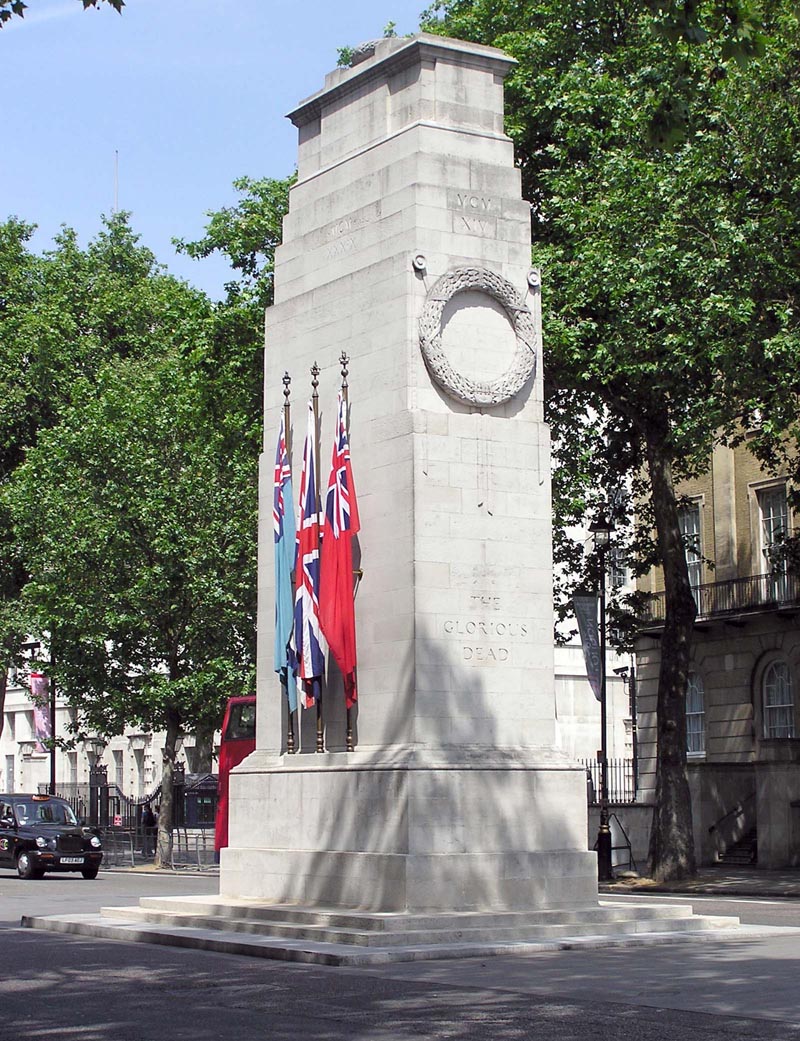
The Cenotaph in London, by Sir Edwin Lutyens.
The question of names is one of the things that has hamstrung the Ground Zero memorial in New York, with bickering and infighting about whether to mark firefighters’ names separately and other concerns emanating from the powerful lobby of relatives of victims.
The most recent war memorial unveiled in London was for the soldiers from New Zealand who died in the World Wars, a ceremony attended by the queen, Tony Blair and around 2000 other grandees and veterans. That this dedication went largely unreported is no surprise. There was no big fanfare, no ringing endorsement in the press, no politicised speeches. The ceremony was good-natured, with smiling veterans and a prime minister relaxed and happy to be away from more pressing duties of state.
It is 61 years since the end of World War 2, and enmity is long past for most. This is amongst a number of memorials that are built in order we might not forget the contributions of those men, although the last of them will soon be dead. Memorials in more durable materials than human flesh will stand in for personal testimony.
In some sense this is the role of all memorials. It doesn’t much matter, traditionally, what kind of people they are, the important thing to represent is usually the cause for which they died, the banner under which they united even until death. But contemporary memorial design is unable to communicate this – multiculturalism has not been codified aesthetically in a way that allows them to make dignified expressions of mourning. Memorial design is in crisis, unable to decide on the imagery that can capture what binds together the 2,979 who died at the World Trade Centre, the millions dead in the holocaust or the thousands dead in Northern Ireland since the Troubles began.
I believe that the public is literate enough to demand more than the dumbness of contemporary memorials, and that artists must meet the yawning need for memorials of meaning. Perhaps Lutyens’ was the last generation to believe in universal imagery from the past. Gavin Stamp quotes the War Graves Commission when it wrote: “in death, all… of whatever race or creed, should receive equal honour under a memorial which should be the common symbol of their comradeship and the cause for which they died.” Either those causes no longer exist, or contemporary architects and designers are unable to create symbols with sufficient power to evoke them. The age of political correctness and multiculturalism has shorn architects and designers of their ability to make symbols that communicate, and the response has been the desolate silence of minimalism.
***
This article was first published in the UK design and architecture magazine Icon
Kieran Long is a writer and critic in London. He has been deputy editor of three architecture magazines (most recently icon magazine) and has written for magazines and journals across the world. He also teaches history and theory of architecture at three universities in the UK. www.kieranlong.com
